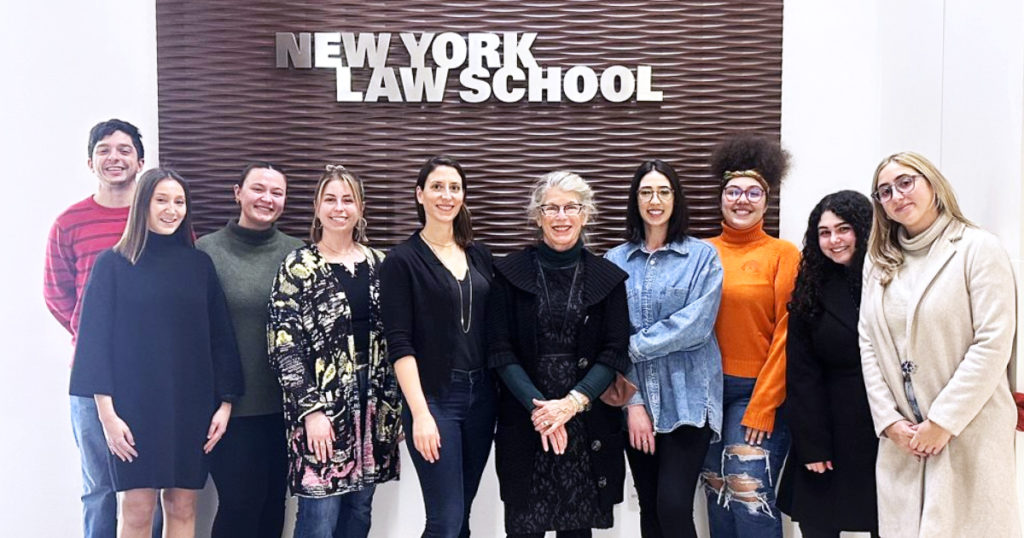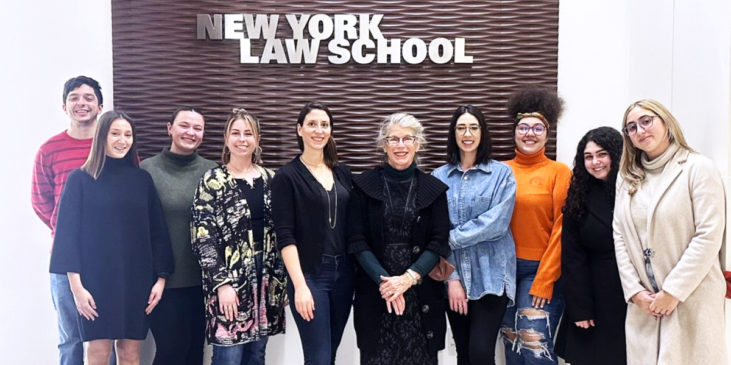
In the Post-Conviction Innocence Clinic, upper-level students represent clients in post-conviction matters under the supervision of faculty members. Students engage in fact investigations geared toward filing post-conviction motions by tracking down court records and transcripts, locating and conferring with prior counsel, conducting prison interviews of clients, and locating and interviewing witnesses.
Here, we hear from two students who worked on behalf of a client in the Clinic whose release they secured—and get a sense of the human relationships behind every case.
Maintaining Innocence for 20 Years
By Sammy Silverstein ’24
This semester in the Post-Conviction Innocence Clinic, my partner and I were assigned the case of a man who has maintained his innocence for over 20 years. He was convicted and sentenced to 22 years to life, and he is presently incarcerated. Following our work with him, he will be coming home at long last.
When we started the Clinic, we were informed that our client was going to become eligible for parole for the first time, so the focus of our clinic work became preparing him for his parole hearing and compiling a parole package to be presented to the Commissioners of the Board of Parole.
A parole package entails a personal statement written by our client, reflecting on who he was at the time of his conviction and how he has grown and reformed while incarcerated; an advocacy letter written by my partner and I explaining why the Clinic took on our client’s case, why we believe his innocence claim, and why we believe he is ready to be released on parole; letters of support written by our client’s family, friends, colleagues, and professors; and a record of our client’s accomplishments while incarcerated.
The trickiest element of creating the parole package was figuring out how to present our client’s innocence claim to the Board of Parole. Typically, in a parole hearing, the Board is looking for an expression of remorse for the crime of conviction. This becomes challenging when the individual maintains their innocence, because they cannot show remorse for a crime they did not commit.
Working with our client, we came up with ideas on how he could express remorse for his past lifestyle—which ultimately played a part in his wrongful conviction—without admitting to a crime that he did not commit. It took many drafts to perfect an advocacy letter which struck the right balance between describing the events of the crime while explaining our client’s innocence and ensuring the Board understood why he should be released from prison.
We spoke to our client after he appeared before the Board of Parole, and he felt optimistic about how the hearing went. Though it seemed clear to our team that he was a great candidate for parole, we were only cautiously optimistic because of the arbitrary nature of the parole process. He went before the Board right before Christmas, so we didn’t expect a result until January.
When our client’s mother called me the Tuesday following his hearing, I thought she was calling to say hello. When I asked her how she was, she told me she was the best she had ever been, and I immediately knew what that meant: Our client had been granted parole. He is coming home.
Working on this case has been an emotional and eye-opening experience. It is one thing to be aware of the injustices of our criminal legal system, but working directly with a person whose life has been permanently altered because of systemic failings has forced me to think critically about how ineffective our systems really are.
In compiling the parole package, our team had multiple phone calls with our client and two in-person meetings with him at the prison where he is currently incarcerated. We have formed relationships with his family and have spoken to his network of friends and colleagues. Every single person we spoke to wholeheartedly supports our client, which has only strengthened our belief in his innocence claim. He is a truly kind person, who—in the face of insurmountable injustice—has remained positive and determined to reenter society.
Though reintegrating into society will be challenging, I believe he will lead a great life because of the love and support of his family and friends—and because of the strength of his character. He is a true inspiration, and working on his case has been a profound honor.
By Emma Ratti ’24
I have known since high school that I wanted to become a Public Defender. When searching for law schools, the Post-Conviction Innocence Clinic at New York Law School particularly stood out as a unique opportunity to work with clients in a criminal law setting.
Of the clients our class worked with this semester, our client is the only one who is currently incarcerated. When going through the trial transcripts, the documents from the District Attorney’s office, and the previous research students have done, I could not believe Mr. M had been found guilty. I turned this shock into motivation to help Mr. M by any means possible.
Mr. M was seeing the Parole Board for the first time in December after serving almost 20 years of his 22-year to life sentence. As we were unfamiliar with the parole process, we met with the Parole Preparation Project to learn more about what a parole package entails. We then called Mr. M for the first time. Mr. M came prepared to every meeting, was organized from the beginning, and we all shared one common goal: to create the best parole package possible and set Mr. M up for the best chance of being released.
We got to work, calling all of Mr. M’s supporters and asking them to write letters of support. While preparing his parole package, we also worked with Post-Conviction Innocence Clinic Co-Directors Professor Gaynor Cunningham and Professor Adele Bernhard on Mr. M’s innocence claim. This included sifting through hundreds of documents in the client file, meeting with the Conviction Review Unit at the Brooklyn DA’s office and creating a digest of the witnesses’ trial testimony.
In October, we finally visited Mr. M at Fishkill Correctional Facility after strategically outlining our plan for the meeting to maximize the time. During our two-hour meeting, we went through the night of the crime with maps and diagrams, discussed how Mr. M wanted his parole package to look, and asked him questions to get to know him and his backstory better. We visited Mr. M again in November, with numerous phone calls in between. At our second meeting, we went through his personal statement, reviewed the advocacy letter my partner and I wrote to submit to the Parole Board, and conducted a mock parole board hearing, where we played the role of the Commissioners in an effort to prepare Mr. M for the upcoming hearing. The meeting ended with hugs all around.
We spoke to Mr. M one week before his hearing to make sure every document was printed and organized, conducted another mock parole board hearing, and shared words of encouragement. One week after his hearing, we spoke to Mr. M again to see how his hearing went. Mr. M spoke with enthusiasm and optimism; as a team, we felt hopeful there would be a positive outcome. On December 27, I received a phone call from his mother telling me Mr. M was coming home. It has been wonderful to share a small part of the overwhelming joy his family continues to experience in anticipation for his arrival home in March.
The experience of working with a client in this capacity is invaluable. Not only am I learning from my client and the Clinic seminars every week, but this material heavily overlaps with my Evidence class and Criminal Procedure: Investigation class. The Clinic brings the doctrinal class material to life. It has been a true honor to be part of the Post-Conviction Innocence Clinic, and I hope anyone interested in criminal law can share this experience.
Experiential Learning at New York Law School’s Plumeri Center
Experiential learning is an integral part of the NYLS education. The Plumeri Center is NYLS’s home for experiential learning, and the Center houses our many clinics, including the Asylum Clinic. Through our top-tier programs, we offer students the opportunity to turn theory into practice: Starting in their first year, students participate in counseling, interviewing, and negotiating exercises in their foundational Legal Practice course. During their upper-level years, students may select from a wide array of experiential learning courses to hone their lawyering skills. Together with a comprehensive legal education, these experiential offerings prepare our students for careers in advocacy.

